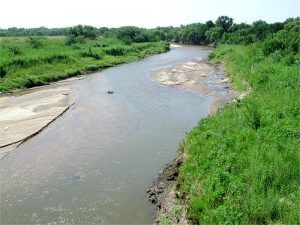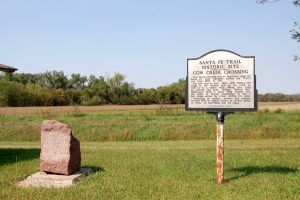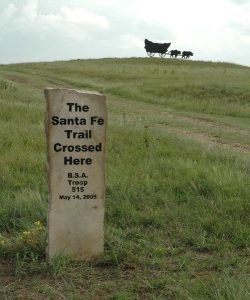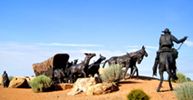Through Rice County, Kansas, the Santa Fe Trail passed almost east and west through the center. It crossed the Little Arkansas River less than a mile into the county and was a significant point of interest on the trail. Still visible when the water is low are the stones laid in the river bed for the wagons to cross on while fording the stream.
About 1000 feet south of the crossing, on the west side of the river, was a 200 x 300 foot stone corral that provided accommodations and protection for travelers. The stone enclosure, having walls 8 feet high and 30 inches thick, also included a trading post. Military troops were stationed here in 1865 and 1867. Unfortunately, all signs of the corral are gone today, but “depressions” can still be seen along the river where soldiers digging dugouts often lived while protecting the trail.
The path then ran west, passing less than a mile south of the present city of Lyons and crossing Jarvis (Chavez) Creek west of the Little Arkansas River, along Jarvis Creek in Rice County. The site is important because Antonio Jose Chavez, a Hispanic trader, was murdered here in 1843. The murder became an international incident, with ramifications in Washington, D.C. and Mexico City.
Travelers then crossed Cow Creek about four miles west of present-day Lyons. This was an important campground to early-day travelers, and in 1853 William Mathewson, the original “Buffalo Bill,” established a trading post near the crossing. In 1858, a stage station was also built. In 1860 “Buffalo Bill” Mathewson hunted buffalo to supply meat to settlers of Eastern Kansas whose cattle herds had been reduced by droughts in 1859 and 1860. In the 1860s, a toll bridge was built about 150 yards upstream. The actual crossing was just south of the present bridge over Cow Creek.
Perhaps the best-known surviving feature of the Cow Creek Crossing area is Buffalo Bill’s hand-dug well. The well was originally dug to serve the Beach Ranch at Cow Creek Crossing, providing water for livestock and travelers on the Santa Fe Trail. Buffalo Bill’s Well is 4 miles west of Lyons on US Highway 56, then 1 mile south on a gravel road. At this point, two gravel roads intersect, and the well is in the northwest quadrant of that intersection near the road.
From Cow Creek Crossing, the trail continued westward towards present-day Chase, Kansas, beyond which prominent trail ruts can still be seen. Today, these ruts are known as “Ralph’s Ruts,” after their owner, Ralph Hathaway. His farm was first homesteaded in 1878 by his grandparents, John L. and Mary E. Hathaway. While John and his sons were breaking sod on the northeast forty acres of this quarter, they plowed up numerous items from burned out wagons, including a pistol, a watch, pieces of hardware, and broken ironstone china — grim evidence of the notorious Plum Buttes Massacre which occurred more than a decade before.
The ruts are located about four miles west of Chase, Kansas, on U.S. Highway 56, then .75 mile north. Some of the finest examples of pristine trail ruts along the entire route, visitors to the site have easy access, a turnout for parking, and a Daughters of the American Revolution marker to point out the location.
From Ralph’s Ruts, about a mile to the west, three large sand dunes once stood called Plum Buttes, named for the many wild plum bushes that grew around their base. About 120 feet higher than the surrounding prairie, they were an important landmark for the Santa Fe Trail travelers. Travelers who sought to avoid the soft, sandy, and nearly impassable soils along the Arkansas River, often crossed the dunes through what was called “Gunsight Notch.” Over the years, the buttes were leveled by wind erosion, creating a wide channel. Though the dunes are gone, the Gunsight Notch and Ruts can still be seen. It was near here that the Plum Buttes Massacre occurred, in which Indians attacked a wagon train, and several people were killed.
© Kathy Alexander/Legends of America, updated April 2023.

West to Barton County





